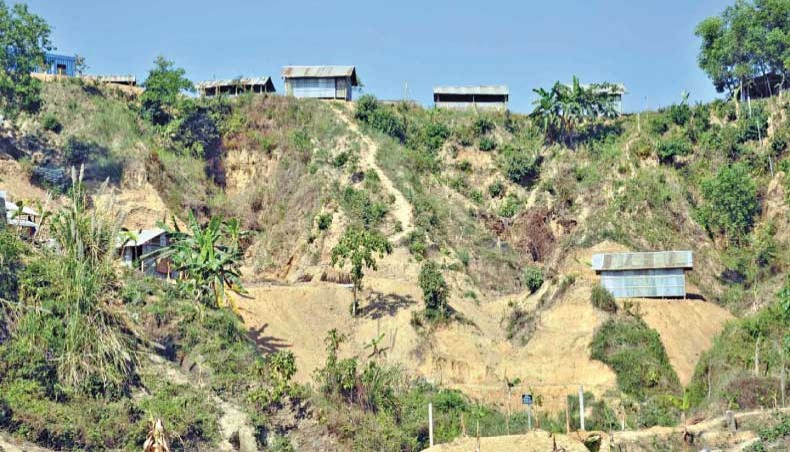Hundreds risk living on Ctg hills
Living dangerously on hills in different areas of the Chittagong city continues, rendering drives against it fruitless.
Although the local administration has been conducting drives from time to time and evicting people from the risky areas, city dwellers say its brings hardly any change as the evicted people come back soon after.
Heavy rainfall that accompanied the cyclone Mora, which lashed southern coasts of Bangladesh on May 29, inundated the low-lying areas of the port city and increased the risk of landslide.
Life at the top of Foy’s Lake, Kusumbagh, Batali hill, Akber Shah and Motijhorna hill in Lalkhan Bazar area becomes more dangerous during the rainy season.
Minara Banu, who lives in Motijhorna hill, told New Age, ‘I am compelled to live here as I cannot afford better residence.’
‘As we are not living free of cost, the government has no right to evict us without giving us land where we would build houses,’ said a desperate Shakil Hossain of the same area.
Halima, a housemaid at Roufabad of Miar Pahar area, tells New Age that she has been residing in the area for 16 years and has no other place to go.
On 31 May, local administration conducted two eviction drives at two hills in Lalkhan Bazar and Bayezid area.
Achiya Khatun, assistant commissioner (Land) Sadar, who conducted the drive at Lalkhan Bazar, told New Age, ‘We told them to leave the place as early as possible. During drive we disconnected their utility.’
Another assistant commissioner Sheikh Zobaier, who conducted drive at Roufabad, told New Age, ‘Some people who had been living at the top of the hill left the place before the drive. We evicted seven families from their houses and cut water supply.’
‘We told them to move to safer places since living on hills is very risky and torrential rains could claim their lives,’ said Zobaier.
Local people have alleged that politically influential individuals have built these slums on the hill slopes in Chittagong, which are home to mainly low income people like rickshaw-pullers and day labourers.
Md Rashidul Hasan, assistant professor of urban and regional planning department of Chittagong University of Engineering and Technology, told New Age that temporary relocation during rainy season was not a solution.
The government should take initiatives to rehabilitate the people living on the hill slopes.
The professor says that hills in these areas are of crumple soil and become vulnerable after heavy rainfall if the surface is not covered with plants.
Shaky lands use and rampant hill cutting are two major factors that have increased the risk of landslide in the hilly areas, Rashidul points out.
The risk is higher for lower income residents of these hills due to hill cutting in areas like Matijhorna, TankiPahar Hill, Kaichchaghona, Lebubagan, Foy’s Lake and Kusumbagh.
Much of the government-owned land is occupied by local goons, who extract soil from these hills for housing projects and brick kilns.
Rashidul explains that when it rains, water dissolves the minerals of the hill soil that loosens its compaction and the soil also becomes heavy by absorbing rainwater.
The steep hill slopes, he says, cannot bear the mass weight of the wet soil or mud and result in landslides.
According to the district administration office, landslides triggered by heavy rains in the city claimed at least 185 lives in the last nine years, with 127 in 2007 alone.
The disasters took place at Lalkhan Bazar, Motijharna, Tankir Pahar, Batali Hill, Akber Shah and Pahartali.
District administration officials said that to prevent further loss of lives, Divisional Hill Management Committee was formed after the 2007 tragedy, which identified 30 hills as vulnerable.
The committee also listed around 2,500 people for rehabilitation but many more have been left out as an estimated 10,000 people are currently living in such areas.
According to the DC office, in 2008, the Hill Management Committee had selected 27 acres of khas land in Hathazari upazila to rehabilitate people affected by landslides.
As this primarily selected land fell under Bangladesh Army Firing Range, the committee selected 5.92 acres of land worth Tk 530 million at Jahan Ali Hat near Kalurghat Bridge, belonging to the Bangladesh Railway.
There was a plan to set up rehabilitation centres there for some 2,400 families but the project failed as the people returned to the hills.
Divisional commissioner Md Ruhul Amin told New Age that evicting all at a time from these identified areas was not viable.
He also said, ‘We have a residential project for the people living in danger. It is under process.’
Ruhul Amin said that it was also the responsibility of the individuals and hills’ owners — Chittagong City Corporation, Chittagong WASA, Bangladesh Railway and Public Works Department — to ensure that such risky abodes did not exist.
- See more at: http://www.newagebd.net/article/17130/hundreds-risk-living-on-ctg-hills#sthash.OrZA8HCi.dpuf











